Tucked neatly into the southwestern cliffs of the Grand Staircase, Zion’s majesty is one of the Wests most alluring. An ever-upward-gaze brings marvel and a medieval worship of natural sculpture. Of all the national parks in our collection, perhaps no other provides a greater magnitude of instant grandeur, than Zion National Park.
Guide to Zion
Zion National Park
The land of Zion, a fabled red-hued land with famous sandstone walls which rise more than 2,000 feet above the canyon floor. From their summits, a jagged land unfolds before the eye, a land of narrow ridges and towering peaks, separated by deep, dark, lonely trenches that are home to the unknown.
Zion is a canyon, a large canyon. It’s not as big as the Grand Canyon, which lies less than 100 miles to the south, but it is every bit as majestic in its glorious stature.
A common visitor to the Grand Canyon will likely observe, that despite the incredible beauty, the view from the rim of the canyons rim is just so darned massive that it almost loses its own reality.
When that same common visitor enters Zion, the reality of the view is immediately clear. Instead of looking out over a massive canyon, the visitor is thrust right into the center of that canyon, with a view that is fit for a god. In fact, there is a section of the park that is called Kolob. In the local Mormon religion, Kolob is the planet where God lives… so I’m told.
Where is Zion?
Zion National Park is located in southwest Utah, near the city of St. George and Interstate 15. The park is accessed via Utah Hwy. 9, which leads from Hurricane to Springdale, where most of the park’s guests enter Zion Canyon. This highway continues through the park, and connects to Hwy. 89 on the east side of Zion.
The park sits at the western edge of a geologic feature called the Colorado Plateau, an uplifted section of the Earth which contains numerous national parks of unparalleled beauty. Just to the west of Zion begins the Mohave Desert, and to the south, the Arizona Strip leads some 80 miles south to the rim of the Grand Canyon.
Exploring Zion
Much of Zion’s most spectacular scenery can be easily observed by the casual visitor with a couple of days on their hands. This is an incredible landscape, and the Zion Canyon shuttle system puts visitors right in the middle of it.
Zion Canyon holds some similarity to the Grand Canyon, which lies a mere 75 miles to the south as the crow flies. Both are massive canyons carved into a sandstone base. Of course the Grand Canyon is much larger and deeper, but they are nevertheless, similar.

The Grand Canyon can seem overwhelming to a visitor standing on its edge looking in at a vast world that he or she may not be able to access, whatever the reason. In Zion Canyon however, the visitor can drive right into the heart of the canyon, get out, and stroll around while staring upward in awe and wonder.
Simply put, it is extremely easy to become intimate with Zion. Its canyon landscape lies naked before the casual traveler, who can access its most treasured secrets without the struggle necessary to gain similar access to its southern neighbor.
There are a few different sections of this park, and each offers its unique attractions and varying levels of crowds. Guests can choose to visit Zion Canyon, the East Side, Kolob Terrace or the Kolob Canyons sections. Each is covered briefly below.
Zion Canyon
At the heart of the park lies Zion Canyon, where we find the park’s most famous attractions. Here, visitors gaze in awe at Angel’s Landing, Weeping Rock, the Court of the Patriarchs, Emerald Pools, the Great White Throne and of course, the Zion Narrows.
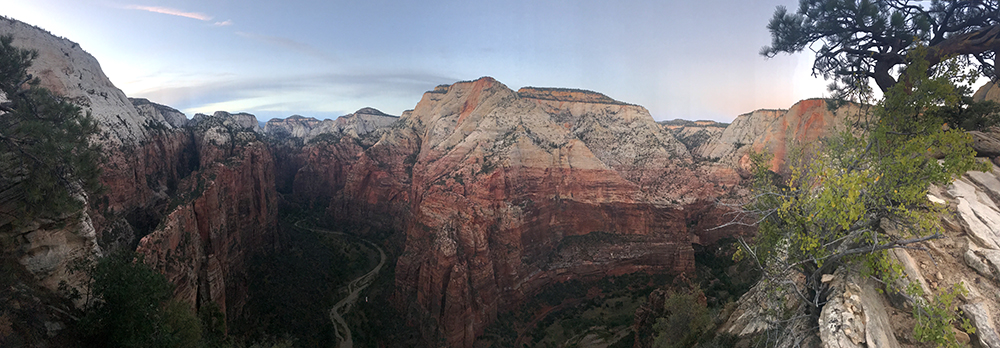
Guests in Zion Canyon also gaze in disbelief at the line of visitors waiting to board the shuttle buses during the busy summer months, as these features ensure a steady stream of visitors. Zion is popular these days and heavy crowds can make it a burdensome affair to negotiate one’s way about the sights of this desert jewell.
Most facilities are found in Zion Canyon, including the Zion Canyon Visitor Center and the Zion Human History Museum. The Watchman and South campgrounds are found near the park entrance and the town of Springdale is just outside the park gate.
Zion Canyon Shuttle
Given the canyon’s popularity, the park service prohibits private motor travel in Zion Canyon most of the year. In place of bumper-to-bumper traffic and fisticuffs, convenient, complimentary shuttles whisk visitors from the Zion Canyon Visitor Center into the narrow walls of the enticing canyon.
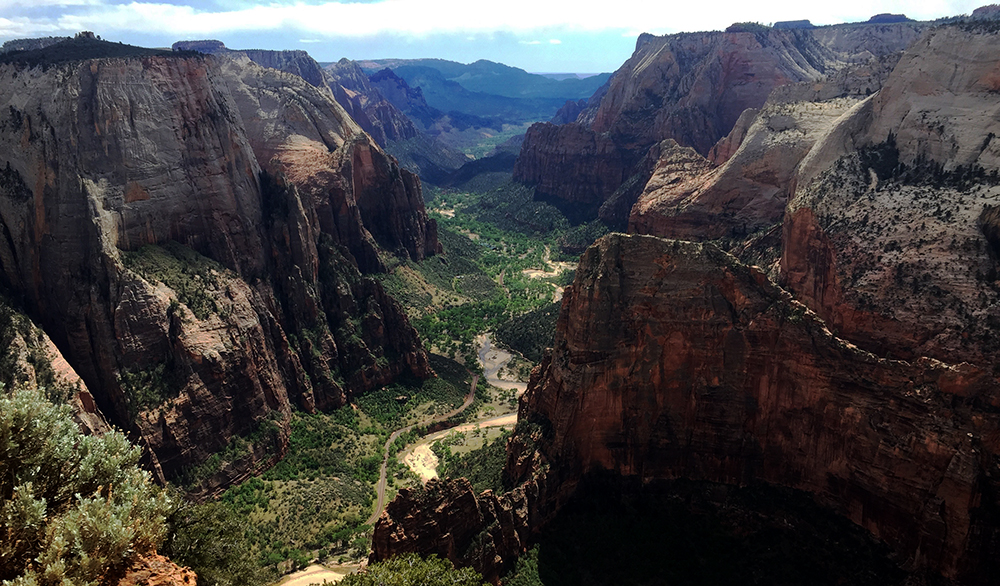
Along the nearly 8-mile route, eight separate stops allow guests to disembark in order to access the park’s attractions and trails. A continuous flow of buses ushers more than 4 million guests a year up and down the canyon.
Motorists who have reservations at the lodge, are permitted to drive to into the canyon with a red pass issued at the park entrance. Private motorized traffic is otherwise prohibited from travel up canyon during most of the year. See the visiting section for more information.
Mount Carmel Tunnel
Travelers based in Zion Canyon or in the neighboring town of Springdale may wish to journey to the park’s east side. The Zion Mt. Carmel Highway, (Utah Hwy 9) is a 12-mile scenic highway that connects the east and south entrances.
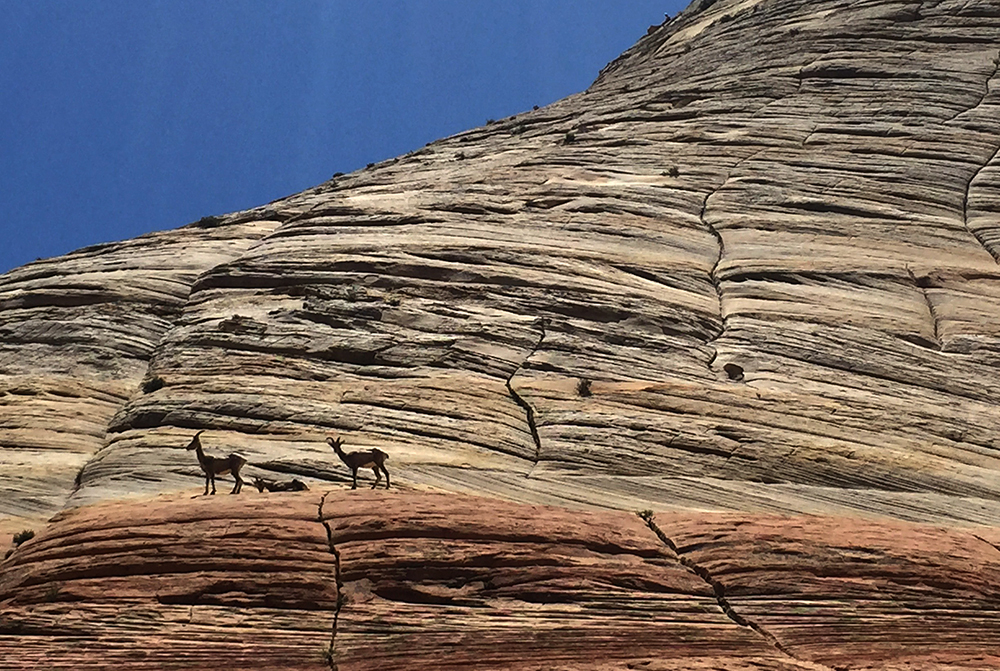
This popular route takes motorists up a thrilling series of switchbacks that ascend more than 800 foot from the canyon floor. The road then leads through the Zion Mount Carmel Tunnel. At 1.1-mile long, this was the longest non-urban tunnel in the country when it was completed in 1930.
This unique sandstone tunnel features six windows, from which views of the surrounding cliffs can be glimpsed by passing motorists. In days-gone-by, these were popular stops at which tourists mugged for cameras. With the heavy traffic of modern times, stopping in the tunnel is prohibited.
Springdale
Just outside the southern gate of the park is the small town of Springdale. This once-remote farming village today may seem the center of the world for tourists who flock to Zion. The small town offers nearly any lodging, dining and guided tour option that a savvy traveler could want.
A quaint little village once dependent on agricultural pursuits, this gateway community has recently recognized its worth in the tourism industry. Here you can now expect to pay in excess of $20 to park your car on the street for the day.
See the visiting section for information on eating, lodging and services in Springdale, along with parking tips to avoid that annoying parking fee.
Zion’s East Side
East of the tunnel, a new scene opens to eager travelers. A land of checkered red rock canyons unfolds to reveal a unique terrain that more resembles Mars than Earth. This is a mountainous world of sandstone, with cracks and small sections of sand providing fertile pasture for the growth of lonely juniper pines and small fields of cactus. Life is rough here, please do not alarm or disturb these hardcore residents.
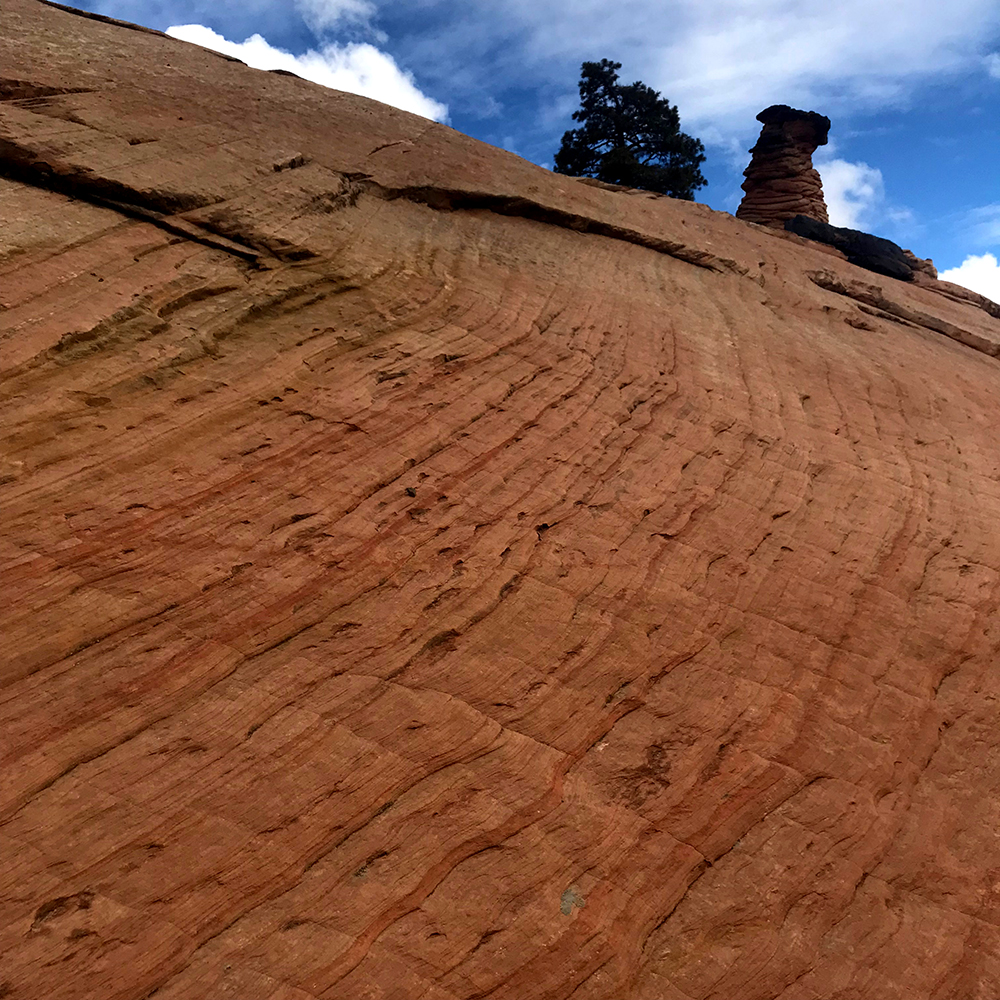
The Canyon Overlook Trail is the lone maintained trail in this area. This is a one-mile, moderate trail to a spectacular view of the highway switchbacks rising from the canyon floor. At the east entrance to the park, the East Rim Trail heads northward. Ten miles later, it reaches the Weeping Rock shuttle stop in Zion Canyon. See the activities page for detailed hiking information.
Although trails are few on Zion’s east side, endless options exist here for secluded adventure. Just park the car in one of the designated pullouts along the highway and venture out into the rocks above. Use caution, these cliffs can place unwary visitors in uncomfortable positions, and gravity quickly becomes more foe than friend.
This area is a favorite for sighting the elusive big horn sheep, who often travel in large herds throughout the steep terrain of Zion’s east side.
Kolob Terrace Road
Other areas of the park warrant investigation too. The Kolob Terrace Road leads into the heights of Zion and is more than worth the drive. This scenic road leads north from the small hamlet of Virgin, about ten miles west of Springdale on Utah Highway 9. Motorists wind through a gorgeous rocky labyrinth and thick forests of aspen before reaching the heights of the park at Lava Point, at an elevation of nearly 8,000 feet. This area is home to the park’s only auto-accessible campground outside Zion Canyon.
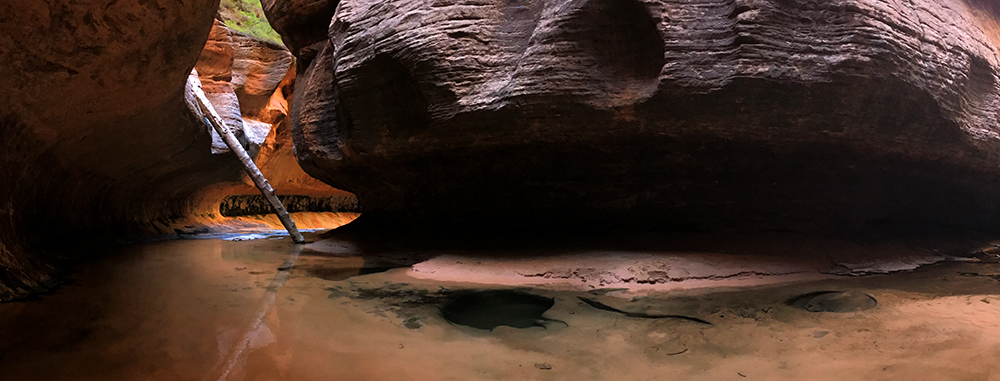
Views from the KT road extend to the south. Distant visible skyline features include the West Temple and the Towers of the Virgin, which soar nearly 4,000 feet above Zion Canyon. The Northgate Peaks hike is a favorite in this area, and the famed Subway slot-canyon hike begins here as well. See the activities page for descriptions.
Kolob Canyons Section
In the park’s far northwestern corner are the Kolob Canyons, a group of narrow parallel box canyons, at exit 40 on Interstate 15. This region is lightly visited, compared to Zion Canyon. There is a 5-mile scenic drive to a fabulous lookout at the Kolob Canyons Viewpoint, and this route offers access to a couple of beautiful hikes.
“One hardly knows just how to think of it. Never before has such a naked mountain of rock entered into our minds! Without a shred of disguise its transcendent form rises preeminent. There is almost nothing to compare to it.”
Fredrick S. Dellenbaugh – 1904
Taylor Creek is a 10-mile roundtrip hike that leads to the Double Arch Alcove, a quiet grotto of red rock, tucked underneath massive sandstone walls. Another option is the La Verkin Creek Trail, which leads to the Kolob Arch, believed to be the largest free-standing arch in the world, at 310 feet across. This trail also links to numerous gorgeous campsites and the Hop Valley Trail, providing access to the Kolob Terrace Road, and connectors to hiking trails southeast toward Zion Canyon.
Playtime
Those who wish to simply enjoy the spectacular scenery can ride the shuttle and stop at points of interest. Numerous short walks provide excellent riverside views of the cliffs and mountains. Some prefer to just chill by the river and take a relaxing dip in its often tranquil waters.
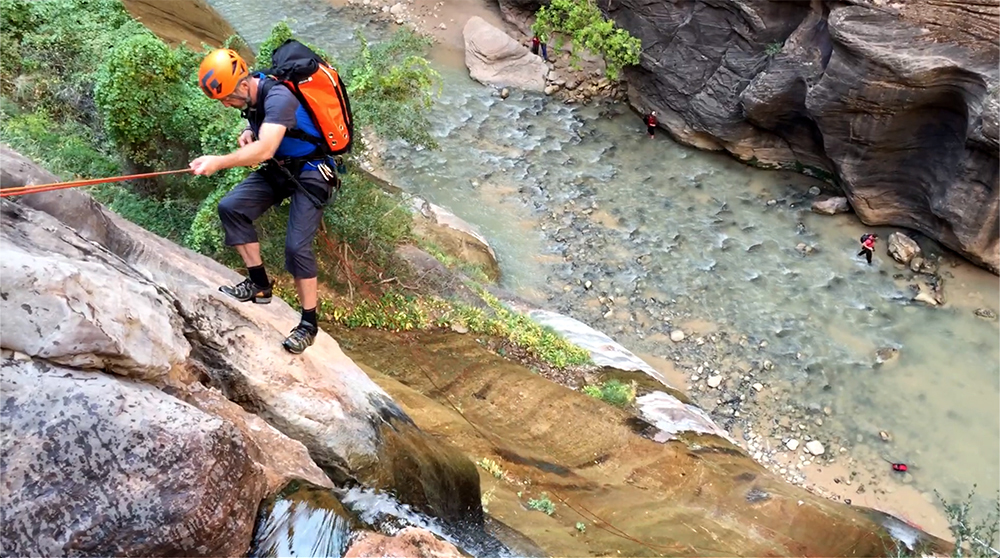
There is no shortage of activities in Zion. Hiking and backpacking are obvious favorites. Angel’s Landing, Observation Point, the Narrows and the Emerald Pools trails offer a variety of challenges and distances for adventure-bound guests. See the activities section for specific hiking descriptions.
Adventure-seeking visitors will find ample opportunities for rock climbing, kayaking, horseback riding, and canyoneering inside the park. Activities outside the park are plentiful as well, and include world-class mountain biking and motocross riding. There are also endless miles of UTV travel in neighboring areas. See the activities page for more information on what to do in and around Zion.
Zion National Park is a small park by western standards, at just over 140,000 acres. Nevertheless, there are many areas to explore and the main canyon is but a small representation of the park. There are numerous other areas in Zion that offer a more secluded experience without the hustle and bustle of the centerpiece canyon.
Seasons in Zion
Seasonal considerations must be kept in mind when visiting this area of the desert southwest. Zion holds a variety of elevations, and temperatures will range accordingly.
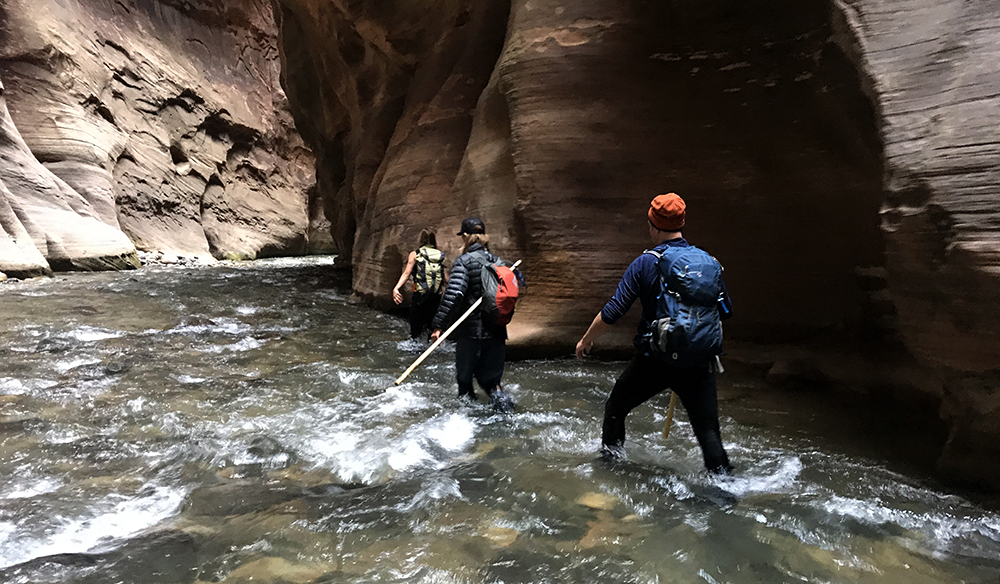
Zion can be cold in the winter, but is generally a mild climate during the slower months, which can make it a favorite time of year for return visitors. Nights will often dip below freezing, but daytime temperatures will often reach the into the 50s and even 60s, which makes for ideal hiking weather. Nevertheless, bring warm clothes, because it can be frigid here too. Views of the canyon’s red cliffs are magically accentuated by a nice white layer of snow.
Spring can be wet, but temperatures are generally mild and prime for outside activity. During years with heavy winter snowfall, the Virgin River will be running heavy. Any flow over 150 cubic feet per second leads the park service to close the popular Zion Narrows hike, which is a great attraction for most visitors. Wet times in the park have seen numerous trail closures as well, due to the fact that sandstone is greatly weakened by moisture. This leads to numerous rockfalls that occasionally result in trail closures.
Zion will definitely be hot in the summer. Temperatures regularly exceed 100° F during summer months, and it’s busy. The late summer usually welcomes the monsoon season in the desert southwest.
During this time, Zion gets pounded by intense but short-lived downpours. Moisture rich clouds roll through the skies in the afternoons, dumping massive amounts of rain in bursts that may not last ten minutes. Don’t underestimate these storms, the cause massive flash floods that have killed too many unsuspecting canyon visitors.
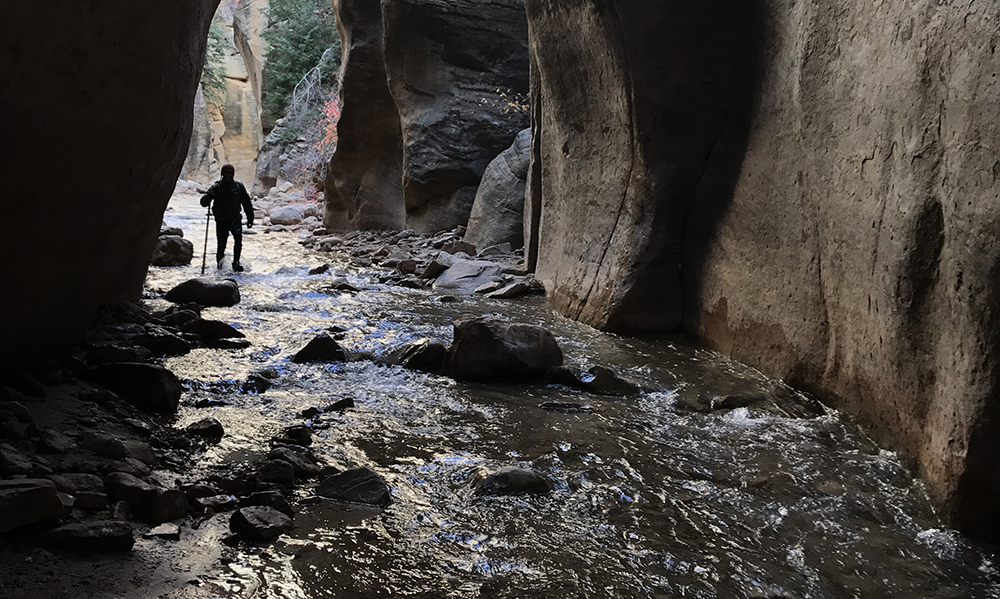
Fall in Zion is spectacular. The summer heat fades into the memory and the days become shorter. The leaves of the cottonwood trees turn golden and glow against the crisp blue skies and the crimson red cliffs. The crowds are still here, but the screaming kids are gone, and the canyon feels as if it’s going into downtime.
Park Junkie Verdict
Zion is a Park Junkie fave, for sure. After more than a decade spent traveling in the parks, I chose to make my home just outside this park. I never tire of the view from my place, and consider myself the luckiest soul in the world to have found such a stunning scene to call home.
Undoubtedly, no land has had a greater influence on the soul of the author than has Zion. With any luck at all, I will continue to roam the cliffs of this magical red rock kingdom for many decades to come. This is home…
See ya there…
Guide to Zion
Relevant Links
National Park Guides

All content found on Park Junkie is meant solely for entertainment purposes and is the copyrighted property of Park Junkie Productions. Unauthorized reproduction is prohibited without the express written consent of Park Junkie Productions.
YOU CAN DIE. Activities pursued within National Park boundaries hold inherent dangers. You are solely responsible for your safety in the outdoors. Park Junkie accepts no responsibility for actions that result in inconveniences, injury or death.
This site is not affiliated with the National Park Service, or any particular park.
